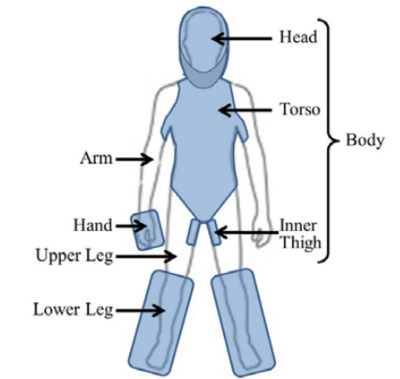Fencing:Glossary
Jump to navigation
Jump to search
Appendix - Glossary
- Line
- In melee combat, a minimum of two combatants, on the same side, in contiguous mutual weapons support range.

- Thrust
- The front (i.e. head-on cross section) of the point of a blade makes contact with the opponent.
- Tip Cut
- The point of the blade is placed upon the opponent and moves across the opponent by dragging along the line of the edge of the sword.
- Draw Cut
- The edge of the blade is placed upon the opponent and slides in the line of the sword by drawing (i.e. contact starts closer to the hilt and ends closer to the tip).
- Push Cut
- The edge of the blade is placed upon the opponent and slides in line of the sword by pushing (i.e. contact starts closer to the tip and ends closer to the hilt).
- Percussive Blow
- The edge of the blade makes contact with the opponent with controlled force such that the opponent can reasonably feel the contact.
- Body
- The body includes the head and entire helmet, the neck, chest, abdomen, back, and the regions on the inner part of the upper arm and the inner thigh extending 4 inches down from the armpit and the groin, respectively.
- Hand
- The hand, including all fingers, up to and including the wrist.
- Arm
- The arm, not including the hand or the part included with the body.
- Upper Leg
- The upper leg, not including the part included with the body, down to and including the top of the kneecap and the crease at the back of the knee
- Lower Leg
- The foot, lower leg, and knee below the upper leg.
- Torso
- The torso includes includes the chest, abdomen, back, and the regions on the inner part of the upper arm extending 4 inches down from the armpit.
- Abrasion Resistant Armor
- Material that will withstand normal combat stresses (such as being snagged by burr on a metal blade) without tearing.
- Examples include, but are not limited to:
- broadcloth
- a single layer of heavy poplin cloth (35% cotton, 65% polyester; "trigger" cloth)
- sweat pants
- opaque cotton, poly-cotton or lycra/spandex mix tights
- Nylon pantyhose and cotton gauze shirts are examples of unacceptable materials.
- Blunt
- (In this use, an adjective) Possessing no sharp edges or point that could reasonably penetrate or scrape bare skin with hand pressure (approximately 5 lb/ 2.25 kg).
- External Reproductive Organs
- In this context, external reproductive organs refers to testicles
- Hemangioma
- A collection of blood vessels at the surface of the skin, characterized as a raised red growth. Hemangiomas which bleed more easily than regular skin must be covered by rigid material.
- Penetration Resistant Armor
- Material that will predictably withstand puncture as demonstrated by passing a penetration test. The following materials are known to pass these tests when new:
- four-ounce (1.60 mm) leather
- four layers of heavy poplin cloth
- ballistic nylon rated to at least 550 Newtons
- commercial fencing clothing rated to at least 550 Newtons
- chain mail made of welded or riveted steel rings that will not admit a 5/32 inch (4 mm) diameter probe. Rings no greater than 5/32 (0.155 inch (4 mm)) in internal diameter made of wire no less than 0.020 inch (0.5 mm) thick meets this requirement.
- The above materials need only be tested at the marshal's discretion; all other materials must be tested the first time new gear is used, or if no marshal on the field knows a given piece of gear to have been tested.
- UnderArmour, Spandex, and other similar stretchy materials are not suitable as puncture resistant materials and must not be included in testing. Kevlar is not an acceptable material as it degrades rapidly.
- Resilient Padding
- Material which compresses under pressure from a thumb but returns to its shape within three seconds once pressure is removed.
- Rigid Armor
- Material that will not significantly flex, spread apart, or deform under pressure of 12 Kg applied by a standard mask tester, repeatedly to any single point. Examples of rigid material are:
- 22 gauge stainless steel (0.8 mm)
- 20 gauge mild steel (1.0 mm)
- 16 gauge aluminum, copper, or brass (1.6 mm)
- one layer of hardened heavy leather (8 ounce, 3.2 mm)
- Perforated material that meets this requirement must have holes no larger than 1/8 inch (3 mm) in any direction, and a spacing of at least 3/16 inch (5 mm) center-to-center. In using these measurements, the perforated material must meet all the requirements of either the imperial or the metric units (or both).
- Vital Body Areas
- The areas of the body that are required to be covered by penetration resistant armor or rigid armor.